Australia is one of the top destinations for students worldwide. Because of its rich cultural diversity, excellent educational system, and pleasant climate, many students decide to continue their education in Australia.
Trade courses in Australia is one of the reasons for the wide range of its educational institutions provided to international students. It allows them to gain practical trade experience, including event management, cooking, carpentry, and automotive. There are many advantages to the Australian VET (Vocational Education and Training) sector for developing your technical and business abilities.
A trading course can help you explore new opportunities, gain expert capabilities, and improve existing skills. It’s a fallacy that trade school prepares students simply for practical work, as these programs play a vital role in high-end business careers.
Let’s check out the top 4 trade courses in Australia,
1. Carpentry Courses.
You can hold positions in many kinds of carpentry jobs by learning the necessary skills in carpentry course. Woodworking and carpentry are the most flexible and adaptive careers you can choose. The consequences of carpentry courses extend beyond the development’s construction phase and touch on many facets of our lives, including interior architecture and exterior façade.
The carpentry courses integrate simulations whenever possible to assist students in thinking about how to implement what they have learned in a controlled situation. However, most of the student’s work will be done with their hands. Written tests can be conducted to check their understanding of the subject matter.
Available Carpentry Courses:
• Carpentry Certificate III
• Carpenter Certificate IV
• Diploma of Building and Construction
Duration of Carpentry Courses:
The carpentry courses are 12 to 24 months long, depending on which certificate or degree you choose.
Cost:
The price for these courses ranges between $9,000 and $15,000.
Requirements
· Must have at least a 5.5 IELTS score.
· 360 hours of professional experience in carpentry.
· Have finished a 10-year qualification in your home country.
Career Options for Carpentry Courses
According to the Australian Government, it has roughly 150,000 carpenters. Despite their diversity, they carry out a wide range of jobs.
You can be an expert in several building sectors thanks to carpentry courses.
Carpenters can specialize in the following areas:
· Commercial Carpenters
· Residential Carpenters
· Industrial Carpenters
· Joinery Carpenters.
· Woodworkers
2. Painting Course:
Trade painters in Australia have many options because the country’s construction is regularly expanding. Because it is their responsibility to make things look gorgeous and appealing, trade painters are important to building construction. If you enroll in this program in Australia and are recognized as a trade painter, you can obtain employment with respectable building companies.
Available Painting Trade Courses:
· Diploma 3 in Painting
· Diploma 4 in Painting
Course duration:
It takes 12 to 24 months to pursue painting courses.
Cost
Course fees range from AU$10,000 to AU$15,000.
Eligibility:
· Completion of the Australian standard 10 qualifications or equivalent internationally.
· A minimum IELTS score of 5.5.
3. Plumbing Course
Everyone is aware of Australia’s shortage of skilled employees. There is a huge demand for plumbers because plumbing requires a licensed plumber. Australian VET Sector Institutes give the best training in the plumbing profession through workshops and theoretical sections.
Available Plumbing Courses:
· Plumbing certificate 3
· Plumbing certificate 4
Duration
The duration for plumbing courses is 1 year.
Cost
The cost of the plumbing program starts at AUD 24,000.
Eligibility:
· Obtain an Australian Year 12 diploma or its international equivalent.
· Have an IELTS score of at least 5.0 or a comparable result on another English language test
4. Event Management Courses
Event management courses come in various shapes and sizes and serve multiple sectors. This implies that you can specialize in a field you’re interested in, such as managing wedding events, corporate events, or athletic events.
You can travel the world while pursuing a career in event management. Because event management is a worldwide sector, much like reality and tourism, the skills you gain are applicable and transferable no matter where life takes you.
The event management courses offer a flexible approach to planning important ceremonies and events. You can work at renowned Australian companies as a Marketing Officer or Public Relations Officer by doing an event management degree. The event Management Courses will teach you how to organize sizable gatherings like weddings, parties, and other events.
Available Event Management Courses:
· Event Management Certificate III
· Diploma in Event Management
· Event Management Advanced Diploma
Educational Pathways
After completing Event Management Courses, you can apply for specific programs.
· Bachelor in management
· Bachelor in business
· Bachelor’s degree in Public Relations
Duration
The period for event management courses ranges from 6 months to 2 years. The length of the course, however, is based on the level.
Cost for Event Management Courses
The cost for this course is $1,000.
Career Options
You can apply for various jobs after completing Event Management Courses, including:
· Event Manager
· Conference Coordinator
· The planner of an event
· Exhibition Manager
Conclusion:
Australia is the perfect choice for international students. Australia’s trade courses prepare students to meet the country’s people’s demand for various services. Carpentry courses, Event management courses are among the top 4 courses in Australia. As a result, trade course students are an important resource for the Australian economy.
The quickest and easiest way to obtain a permanent resident visa in Australia is to enroll in one of the Trade courses offered there. To verify if you are eligible for the trade course at your school, check the specific requirements for that program and then begin the application process.
Contact our registered education consultant at The Migration for more details and guidance.



